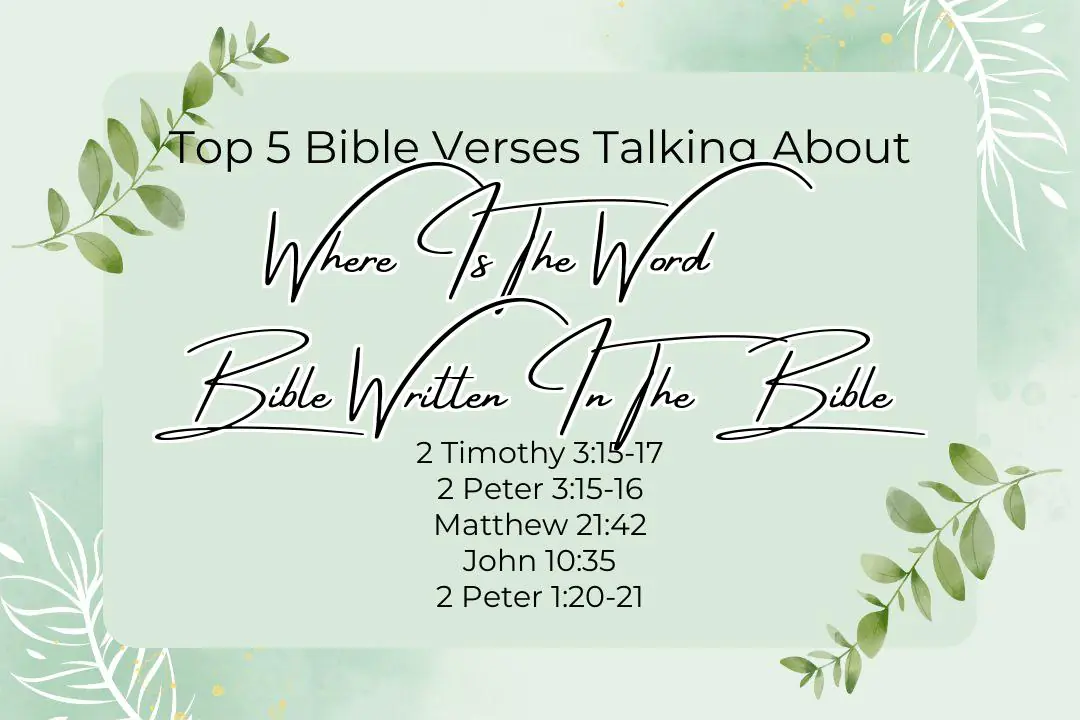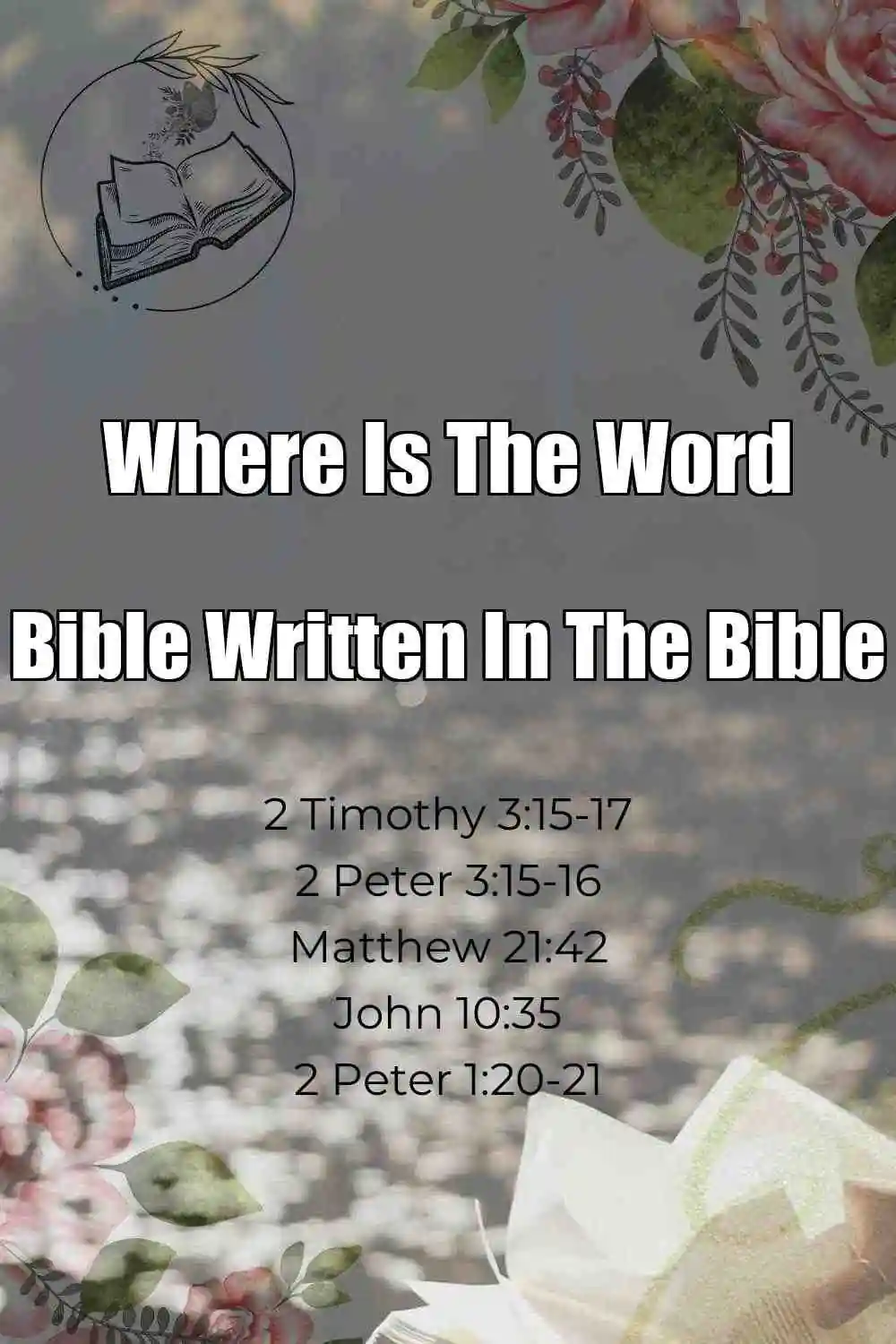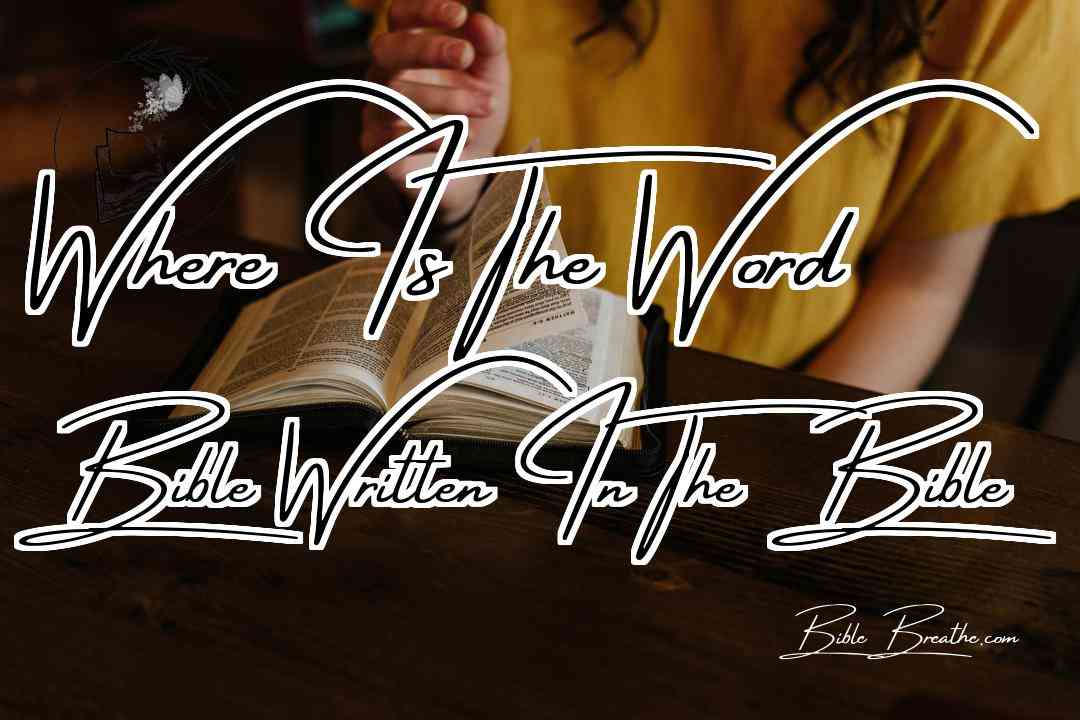To be honest, I never really thought about where the Bible got its name from – was it a person, a place? More to the point, does it even say the word ‘Bible’ anywhere inside it? This might sound like some random trivial thing, but trust me, it goes way deeper than that – like, have you ever stopped to think about how something so simple actually has this insane history, and what that means for all the folks who’ve based their faith on it?
Top 5 Bible Verses About Where Is The Word Bible Written In The Bible
As I dug deeper, I came across some Bible verses that kinda blew my mind. These ones in particular, I reckon, are a good spot to start poking around – lots to think about, you know? They help clarify things, add a bit of nuance to what we’ve been talking about so far…

Picture by BibleBreathe.com about Where Is The Word Bible Written In The Bible
Understanding the Term ‘Bible’
Definition of the word ‘Bible’
Sitting here thinking, the importance of the Bible hits me, and, gotta ask, where does it actually say “Bible” in, well, the Bible? Sounds ridiculous but, honestly, makes you wonder what we’re even talking about when we say “Bible”.
The word “Bible” – basically, a bunch of sacred writings Christians believe is the word of God.
Etymology of the word ‘Bible’
So, where’s this word come from, then? Well, it originates from the Greek word “biblia”, which just means “books” or “scrolls” – makes sense, since it’s a collection of writings from loads of different people.
Apparently, “biblia” comes from “byblos”, the plant they used to make scrolls from – pretty cool how the actual word we use for the Bible’s connected to how they made the stuff.
Historical development of the Bible as a collection of scriptures
I was reading the Bible the other day, and it says,
“All scripture is given by inspiration of God, and is profitable for doctrine, for reproof, for correction, for instruction in righteousness” (2 Timothy 3:16, KJV).
I mean, we talk about the Bible like it’s this one cohesive book, but really, it’s just loads of separate writings that were collected together over time.
From what I’ve learned, the first Christian communities probably just used the Septuagint (the Greek version of the Hebrew scriptures), but after those big councils (Nicaea and Trent), that’s when things started coming together.
I guess I got a bit sidetracked, but the answer to the question’s still “no”, the Bible doesn’t actually say “Bible” anywhere in it – seems obvious now, but took me a minute to get there. Anyway, didn’t realize how interesting the story behind it was till now.
References to Scripture within the Bible
I gotta admit, as I dug deeper into this whole Bible thing, a question’s been naggin’ at me for a while – where’s the word “Bible” actually mentioned in the Bible? Turns out, it’s nowhere to be found. But what’s cool is there are lots of passages that talk about Scripture, and I thought it’d be neat to check ’em out with you.
Passages that refer to ‘scripture’ or ‘the scriptures’
I came across this verse in Romans that goes,
“For what saith the scripture? Abraham believed God, and it was counted unto him for righteousness” (Romans 4:3, KJV).
It’s like, yeah, Scripture isn’t just a bunch of words on a page – it’s a powerful tool for learning about faith and doing the right thing. Then there’s this other passage in 2 Peter that says,
“As also in all his epistles, speaking in them of these matters; in which are some things hard to be understood, which they that are unlearned and unstable wrest, as they do also the other scriptures, unto their own destruction” (2 Peter 3:16, KJV).
It’s warning us that we gotta be careful not to mess up what Scripture’s sayin’, or we might end up hurtin’ ourselves.
Passages that refer to ‘the law’ or ‘the law and the prophets’
Even Jesus himself referred to Scripture as “the law and the prophets”. He’s like,
“Think not that I am come to destroy the law, or the prophets: I am not come to destroy, but to fulfil” (Matthew 5:17, KJV).
It’s pretty clear that Jesus wasn’t tryin’ to get rid of the law; he was all about fulfillin’ it. And his teachings still apply today.
Passages that refer to ‘the word of God’ or ‘the word of the Lord’
I also noticed the Bible talks about Scripture as “the word of God” or “the word of the Lord”. Like in Hebrews 4:12, where it says,
“For the word of God is quick, and powerful, and sharper than any twoedged sword, piercing even to the dividing asunder of soul and spirit, and of the joints and marrow, and is a discerner of the thoughts and intents of the heart” (Hebrews 4:12, KJV).
Scripture’s more than just words; it’s somethin’ that can really change our lives. The Psalmist hits it on the head when he says,
“Thy word is a lamp unto my feet, and a light unto my path” (Psalm 119:105, KJV).
It’s our guide, our comfort, and our source of strength, all rolled into one. So yeah, the word “Bible” might not be in the Bible itself, but the idea of Scripture’s all over the place, showin’ us just how important it is in our lives.
Specific References to Written Scripture

Photo modified by BibleBreathe.com. Original photo by Rod Long on Unsplash
My curiosity got the better of me as I dug deeper into this ancient book – so, where does it actually mention the word “Bible”? i mean, I’d always assumed it was in there somewhere. this little puzzle had been vexing scholars & theologians for, oh, a couple of centuries or so.
The Significance of Sacred Writings
something that always stuck with me – a letter from the apostle Paul to Timothy:
“And that from a child thou hast known the holy scriptures, which are able to make thee wise unto salvation through faith which is in Christ Jesus.” (2 Timothy 3:15, KJV).
the significance here is: Paul isn’t just referring to scripture in the abstract… these sacred writings are a foundation – the bedrock, really – for Timothy’s entire faith. pretty serious stuff, this reverence for the written word.
The Authority of Scripture
& then we have Peter:
“As also in all his epistles, speaking in them of these matters; in which are some things hard to be understood, which they that are unlearned and unstable wrest, as they do also the other scriptures, unto their own destruction.” (2 Peter 3:16, KJV).
for me, it’s telling that Peter slips into this, more informal tone when speaking about scripture – he writes of the written word with real weight, with authority. clearly, Peter had a seriously high opinion of scripture.
Other Passages that Refer to Written Scripture
there’s the odd text elsewhere – passages like Matthew 21:42, John 10:35 or Acts 17:11 spring to mind. We see time & time again, early Christians did what most Christians do today – grounding their worldview in the scriptures.
Sitting here now.. i’m remembering these stories for the first time – We don’t simply collect tales & parables between the covers of our ‘good book’ but carry on a centuries-old relationship, alive & wrangling with an intricate, stubbornly divine voice that interrupts us, shakes us awake… i’d more or less already come to understand, studying this wily thing – an explicitly stated origin may have puzzled me; yet some lines endure down thru it all.
How the Biblical Canon Came to Be
A Divine Library, of Sorts
I’ve often found myself lost in thought while reading the Bible – where does it actually mention the word “Bible”? Turns out it doesn’t, which I found kinda odd. I discovered it comes from the Greek word “biblia,” basically just meaning a bunch of books or scrolls. Learning about this process makes me appreciate how the scripture all came together.
The Early Christian Church’s Big Job
Collecting and figuring out which scriptures were legit was no easy feat, it was like trying to find all the pieces to a super-old puzzle. The early church played a huge role in deciding which texts were the real deal, carefully going over each one to see if it was actually from God or not. I can just picture the apostles and other church leaders praying, arguing, and discussing which ones should make it in.
The Bible puts it this way,
“All scripture is given by inspiration of God, and is profitable for doctrine, for reproof, for correction, for instruction in righteousness:” (2 Timothy 3:16, KJV).
That just shows that scripture isn’t just something people wrote, but it’s actually from God, you know?
Councils that Made a Real Difference
Later on, at the Councils of Nicaea (325 AD) and Trent (1546 AD), people got together to really work out what was gonna be in the Bible. These councils basically decided on the 66 books we use today, which I think is pretty wild. I’m pretty thankful they put in the work to get all that figured out for us.
Martin Luther said this about the Bible,
“The Bible is the cradle wherein Christ is laid.”
The Bible really is where our faith comes from, so studying how it came together just makes it even more meaningful to me, you know?
Understanding How It All Went Down
It seems way more interesting to look at how it was formed instead of just taking it for granted. Like people wouldn’t normally include certain writings just because. I think it helps me respect the book even more and take it seriously.
The Bible as One Big Collection of Scriptures
All in One Book
That one day still sticks in my head when I thought to myself, “where’s the actual word ‘Bible’ mentioned in the Bible, anyway?” I mean, it’s a pretty simple question, but it took me on this wild journey, and kinda changed how I feel about the whole thing. So I dug deeper, started reading Scripture like crazy, and suddenly it all started making sense – that the Bible’s not just a a bunch of separate books mashed together, but one big cohesive story.
The Bible says,
“For the prophecy came not in old time by the will of man: but holy men of God spake as they were moved by the Holy Ghost.” (2 Peter 1:21, KJV).
This verse right here made me realize that these Bible writers, they weren’t just chillin’ at home writing whatever came to mind – but more like, they were totally guided by the Holy Spirit. That’s what makes the Bible all work together like a well oiled machine, you know?
So What’s the Bible’s Deal, in Christian Terms?
As Christians, we all agree that the Bible’s like the go-to guide on, well, pretty much everything that has to do with faith and such. It shapes how we see the world and even kind of gives us a foundation to live off. Like, remember that one Psalm where it’s all:
“Thy word is a lamp unto my feet, and a light unto my path.” (Psalm 119:105, KJV).
Yeah, it’s like that. The Bible’s like, my map, my buddy, my go-to guy when life is good or completely rough. And it’s the anchor for my relationship with God and with all the other people in my life, so.
What the Bible Means to Both Jewish and Christian Traditions
Both Jews and Christians think of the Bible as this awesome shared thing that links us in our whole pursuit of God. The Apostle Paul nailed it when he wrote,
“For whatsoever things were written aforetime were written for our learning, that we through patience and comfort of the scriptures might have hope.” (Romans 15:4, KJV).
The Bible is hope in a nutshell – like, proof that God’s always looked out for people, even when it seemed like he wasn’t around. Whether I’m reading those super old stories in the Hebrew Scriptures, or stuff in the New Testament, it all ties back to this whole God guy who created me, then came to save the day when things didn’t go exactly according to plan…which honestly still happens alot.
Implications of the Bible’s Self-Reference
Theological Implications of the Bible’s Self-Reference
Pondering on this thing, I always wonder where exactly does it say “Bible” in, you know, the actual Bible. Like, shouldnt it say that somewhere? Yet it kinda makes sense that I’m not findin it cause – duh – its just assumed this collections of books and stories is what we’re supposed to rely on.
The Bible says,
“All scripture is given by inspiration of God, and is profitable for doctrine, for reproof, for correction, for instruction in righteousness” (2 Timothy 3:16, KJV).
For some reason, that right there, seems to put a major emphasis on the fact these writings aren’t like anything else written by normal people – apparently god feels its fair to tell others about them.
The Relationship Between Scripture and Tradition in Christian Theology
When you consider scripture vs tradition and who trumps who – then the Reformers words kinda do echo all of that in this notion that tradition – nope- scripture, must be ultimate king pin that tells u exactly how to live, not customs of a heritage in us. This remains relevant but sometimes not totally understandable, where you just gotta take a leap a faith i guess (which feels hard really)…
The Bible says,
“But the word of the Lord endureth for ever. And this is the word which by the gospel is preached unto you” (1 Peter 1:25, KJV).
Makes you really wanna be like it, kinda outta reaches when talking through – the Lord – but even then it remains. More, however it feels always bigger.
The Ongoing Significance of the Bible in Contemporary Christian Practice
Right now, when quite often Bible doesn’t totally get what he wants, its kinda our cultural heirloom… sounds probably well that just, right? And actually even kinda better – bein well-written where we really lose us voice to the pages. At last our biggest fears as people are seen yet accepted despite their weirdness so at last its just our final moments. Its alive in most profound ways – lives and breaths- I mean those pages when done.
“Martin Luther said one great line and it was that the actual Bible really, is where a full divine ‘Christ story originates'” When its thought about a real lot, but kinda like i don’t ever want to have heard ’bout Jesus and get all too trapped in a book or the way he thinks. When instead – when when not saying it seems so, so vital – may still hold but despite be, it cannot grow more distant be simply “i have totally become those words, its how and why my lives been made free.”
What Do You Think?
Share your unique interpretation of this verse in the comments. Your personal insights could offer valuable perspective and support to our community.
If this article was helpful, let your friends know and explore more at BibleBreathe.com!

Photo modified by BibleBreathe.com. Original photo on Unsplash.
Frequently Asked Questions About Where Is The Word Bible Written In The Bible
What does the Bible say about itself?
Honestly, I find it pretty cool that the Bible calls itself God-breathed – like, it’s legit God’s words. According to 2 Timothy 3:16-17, it’s good for teaching us stuff, correcting us when we’re wrong, and just generally guiding us through life. Oh, and get this, Isaiah 40:8 says its words are gonna last forever, unchanged and all that.
Is the word Bible mentioned in the Bible?
So I looked into it, and it turns out the word ‘Bible’ isn’t actually in the Bible. But, fun fact, it comes from this Greek word ‘biblia’ which basically means a bunch of books. Anyway, in 2 Timothy 3:16, the Bible refers to itself as a collection of sacred writings – kinda like how we think of it today.
Where did the term Bible come from in Christian history?
As far as I can tell, the term ‘Bible’ originated from that Greek word ‘biblia’, meaning books. It’s kinda obvious, but it refers to all the sacred writings that make up our Christian scriptures. Apparently, this term started popping up in the early days of Christianity, and just kinda stuck.
Matt Turner
I’m Matt, and I love breaking down Bible verses in a way that’s easy to understand and apply to everyday life. My goal is to help you connect with God’s Word and find practical ways to live it out. Whether you’re new to the Bible or just looking for some fresh insights, I’m here to walk with you and share what I’ve learned along the way.

